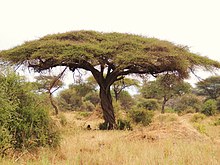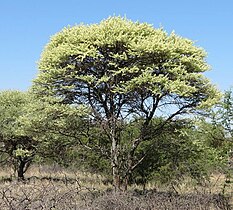Vachellia tortilis
| Umbrella thorn acacia | |
|---|---|

| |
| Specimen of the nominate subspecies in Serengeti National Park | |
| Scientific classification | |
| Kingdom: | Plantae |
| Clade: | Tracheophytes |
| Clade: | Angiosperms |
| Clade: | Eudicots |
| Clade: | Rosids |
| Order: | Fabales |
| Family: | Fabaceae |
| Subfamily: | Caesalpinioideae |
| Clade: | Mimosoid clade |
| Genus: | Vachellia |
| Species: | V. tortilis
|
| Binomial name | |
| Vachellia tortilis (Forssk.) Galasso & Banfi[2]
| |
| Subspecies and varieties[3] | |
| |

| |
| Range of Vachellia tortilis | |
| Synonyms | |
Vachellia tortilis, widely known as Acacia tortilis but now attributed to the genus
Distribution and growing conditions
Vachellia tortilis is widespread in Africa, being found in countries like Tunisia, Morocco, Uganda, Angola, Zimbabwe, Djibouti, and Botswana. It tends to grow in areas where temperatures vary from 0 to 50 °C (32 to 122 °F) and rainfall is anywhere from about 100–1,000 mm (3.9–39.4 in) per year.[6]
Characteristics
In extremely arid conditions, it may occur as a small, wiry bush. In more favorable conditions, it grows up to 21 m (70 ft) in height.
The plant is known to tolerate high alkalinity, drought, high temperatures, sandy and stony soils, strongly sloped rooting surfaces and sandblasting. Also, plants older than two years have been observed to be somewhat frost resistant.
Importance
Timber from the tree is used for furniture, wagon wheels, fence posts, cages, and pens.
The Umbrella thorn is also an important species for rehabilitation of degraded arid land; it tolerates drought, wind, salinity and a wide range of soil types, and has the additional benefit of fixing nitrogen, an essential plant nutrient, in the soil via its interaction with symbiotic root bacteria.
-
The pods are curled.
-
It has a combination of paired straight and paired hooked thorns, from which the Afrikaans name derives, meaning "hook and prick".
-
The southern subspecies heteracantha, here seen in flower, is smaller and often without a spreading crown.
It is also the tree under which the historic pledge of allegiance of Hudaybiya of Muhammad was held, as God says in the Quran, "Allah's Good Pleasure was on the Believers when they swore Fealty to thee under the Tree: He knew what was in their hearts, and He sent down Tranquillity to them; and He rewarded them with a speedy Victory;"[9] Abu Zubayr said in Sahih Muslim that, "Umar was holding the latter's hand (when he was sitting) under the tree (called) Samura[10]."[11]
References
- ^ "Vachellia tortilis". IUCN Red List of Threatened Species.
- hdl:10566/3454.
- ^ ILDIS Legumes of the World
- ^ XVIII International Botanical Congress, 23–30 July 2011, Melbourne Australia
- ^ Vachellia tortilis (as Acacia tortilis (Forsk.) Hayne), Purdue University, December 1997.
- ^ "handbook on seeds of dry-zone acacias". www.fao.org. Retrieved 2017-08-03.
- ^ World Agroforestry Centre
- ^ "Acacia tortilis". www.hort.purdue.edu. Retrieved 2017-08-03.
- ^ Al-Quran 48:18
- ^ the Arabian name used at that time for this tree.
- ^ Sahih Muslim 1856




